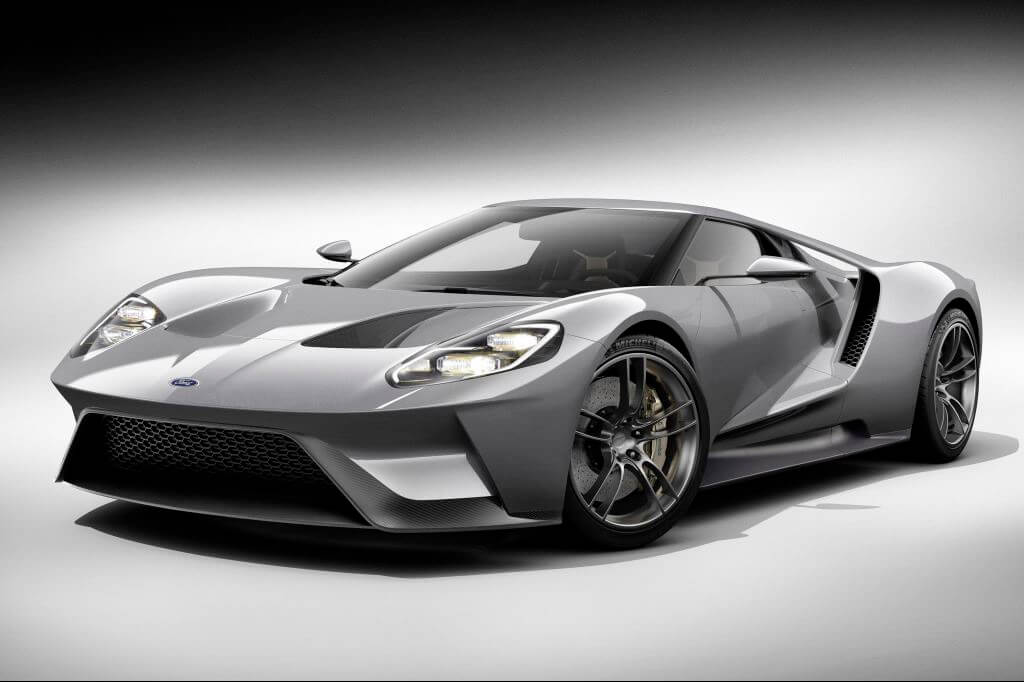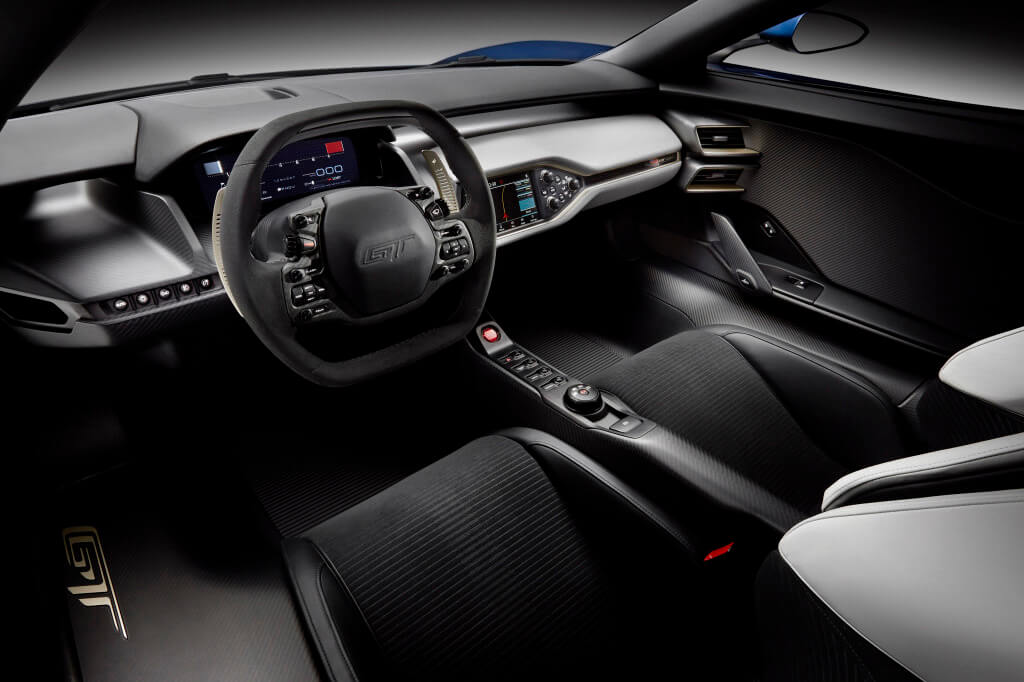Ford GT (Mk2) Concept
Description
The Ford GT (Mk2) Concept is a 2-seater sports car concept planned as a successor to the Ford GT (2002-2006).
Story
Rumors of a successor to the first generation Ford GT have been raging since the model was discontinued in 2006. This time, the new supercar had to wait only 9 years, not 35. Development was carried out in the strictest secrecy, even within Ford.
So, in 2015, at the North American International Auto Show, as well as in the computer game Forza Motorsport 6, a new, clean-sheet, second-generation Ford GT was presented, the production of which was scheduled for 2016.
The new model marked the 50th anniversary of the GT40's victory in 1966 at the 24 Hours of Le Mans. For this purpose, four instances of the Ford GT LM racing modification were built in 2016 for the Ford Chip Ganassi Racing team. They made their debut at the 24 Hours of Daytona where they finished 7th and 9th in the class. The Ford GT LM then matched its predecessor's Le Mans achievement by winning the GTE-Pro category and finishing 1st and 2nd in the Fuji and Shanghai 6 Hours. 1st at Silverstone and 2nd at Le Mans followed in 2017.
The Ford GT was awarded the North American 2015 Pre-Series Concept Award, as well as the top honor for 2015 Top Concept. Ford has been a finalist for the 20th time in the category and for the 5th time it has been awarded the top prize in the category.
Engine
V8 and V12 engines were considered as the power plant, but, in the end, it was decided to use the Ford EcoBoost V6 engine due to its compactness, which gave more freedom to designers.
The twin-turbocharged Ford EcoBoost V6 engine was the most powerful production Ford EcoBoost engine in history at that time. It provided more than 600 hp. and worked in tandem with a 7-speed dual clutch transmission and steering wheel control paddles.
Chassis
At the heart of the new GT was a carbon fiber monocoque with aluminum front and rear subframes and carbon fiber body panels. The car's windshield was made from Corning's Gorilla Glass, which is also used to make smartphone screens. Such glass reduced the weight of the car due to its thinness, but had the same strength as a conventional windshield.
Like its predecessor, the new Ford GT was designed only as a 2-door coupe with a central layout, with the aim of improving stability by keeping the center of gravity closer to the center. The weight distribution of the new GT was 43% front and 57% rear.
Variable ride height independent push-rod suspension, carbon-ceramic brake systems and 20-inch wheels were standard.
Exterior
The design goal was for the overall look of the second generation GT to be recognizable as part of the GT lineup, which meant, for example, a cropped nose piece, round taillights and raised twin tailpipes. But, unlike the first generation car, the new GT had butterfly doors that no longer included an element integrated into the roof.
Drag has been minimized and downforce has been increased with a teardrop-shaped body for active aerodynamics. The most notable exterior features of the new GT were the open airflow tunnels built into the car's rear fenders, called "flying buttresses". The front end of the GT featured a GT40-style cutout and hood vents that let oncoming air through the car's roof. At the rear, there was a large diffuser and hollow, round taillights that forced out air drawn in through vents built into the buttresses. The GT's active rear spoiler could be adjusted and adapted to different conditions and driving modes depending on the required downforce.
Interior
The interior of the Ford GT was not much more luxurious than that of a racing car. The trim was made of carbon fiber and Alcantara. The seats were built into the monocoque and were not adjustable. For the convenience of landing, it was necessary to adjust the steering column and pedal assembly. All the main buttons were centered on a square Formula 1-style steering wheel, behind which was a digital instrument cluster. To the right of it was the display of the information system, and below it, on a narrow console, was the engine start button and the rotating gear selector.
Sources
Specification
| Bodywork | |
|---|---|
| Presentation | |
| Years of production |
2015
|
| Body type |
купе
|
| Number of doors |
2
|
| Number of places |
2
|
| Engine | |
|---|---|
| Engine type |
бензиновый
|
| Engine location |
центральное, продольное
|
| Engine model |
Ford TwinTurbo EcoBoost 3.5 V6
|
| Cylinders |
V6
|
| V-angle |
60°
|
| Capacity (cc) |
3496
|
| Power output (hp / kW /) |
656 /
482 /
|
| at rpm |
6250
|
| Torque (N·m) |
746
|
| at rpm |
5900
|
| Number of valves |
4/24
|
| Valvetrain |
DOHC
|
| Block material |
алюминиевый сплав
|
| Dry sump |
да
|
| Fuel system |
впрыск
|
| Turbocharger |
2
|
| Specific | |
|---|---|
| Specific output (hp/litre) |
187,64
|
| Specific output (hp/tonne) |
445,05
|
| Specific output (kg/hp) |
2,25
|
| Specific torque (N·m/litre) |
213,39
|
| Specific torque (N·m/tonne) |
506,11
|
| Transmission | |
|---|---|
| Driven wheels |
задний
|
| Clutch |
двухдисковое
|
| Gearbox model |
Getrag 7DCL750
|
| Gearbox |
роботизированная
|
| Number of speeds |
7
|
| Suspension | |
|---|---|
| Front suspension |
push-rod
|
| Rear suspension |
push-rod
|
| Elastic elements in front |
пружины
|
| Elastic elements in rear |
пружины
|
| Front anti-roll bar | |
| Rear anti-roll bar | |
| Wheel size front |
8,5J×20
|
| Wheel size rear |
11,5J×20
|
| Tire brand |
Michelin Pilot Sport Cup 2
|
| Tyres front |
245/35 R20
|
| Tyres rear |
325/30 R20
|
| Steering | |
|---|---|
| Steering type |
шестерня-рейка
|
| Power steering |
гидравлический
|
| Turning diameter (m) |
12,2
|
| Brakes specs | |
|---|---|
| Brakes front |
дисковые вентилируемые перфорированные
|
| Brakes rear |
дисковые вентилируемые перфорированные
|
| Brand of brakes |
Brembo
|
| Disc material |
карбон-керамика
|
| Number of caliper pistons (front/rear) |
6/4
|
| Anti-lock braking system |
да
|
| Dimensions and weight | |
|---|---|
| Body |
монокок с панелями
|
| Body material |
углеволокно
|
| Length (mm) |
4763
|
| Width (mm) |
2004
|
| Height (mm) |
1110
|
| Wheelbase (mm) |
2710
|
| Front track (mm) |
1694
|
| Rear track (mm) |
1661
|
| Ground clearance (mm) |
120
|
| Drag coefficien |
0,350
|
| Dry weight (kg) |
1385
|
| Curb weight (kg) |
1474
|
| Weight distribution (%) |
43/57
|
| Performance specs | |
|---|---|
| Ecological class |
Евро 6
|
| Fuel tank capacity (l) |
57
|
| Fuel type |
Аи-98
|
| Dynamic specs | |
|---|---|
| Acceleration 0-100 kph (s) |
3,5
|
| Top speed (kph) |
348
|
|---|---|
| Top speed (mph) |
216
|



